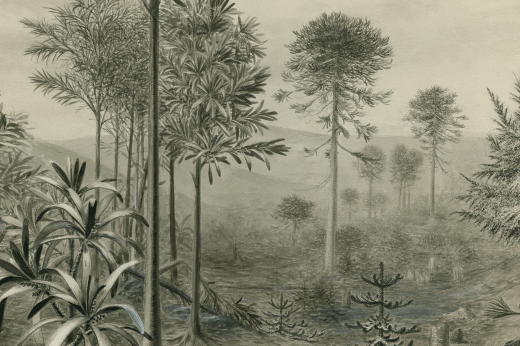A trio of rare and beloved monkey puzzle trees (Araucaria araucana) recently made big moves at Brooklyn Botanic Garden. After living in containers outside the Visitor Center for the past decade, Garden gardeners planted them in the conifer collection near Daffodil Hill, where they’ll have room to grow.
Also known as Chilean pine trees, monkey puzzle trees can reach a height of around 130 feet. Keep an eye out for their distinctive spiky branches, which are flexible and—as the name implies—difficult to climb.
We reached out to Karina Speziale, a researcher at the Biodiversity and Environment Research Institute at the National University of Comahue in Argentina, to learn more about this unique tree.
“They are iconic,” she said. “We love these trees down here.” Native to the Andes mountains in Chile and western Argentina, Araucaria araucana is the national tree of Chile, and highly important to the Mapuche people in the region. The species is part of an ancient lineage of conifers, and is often described as a “living fossil.” (Scientists believe the trees’ sharp, distinctive leaves may have evolved as a defense against dinosaur predation.)
Today, monkey puzzle trees are endangered. European settlers cleared forests for agriculture, livestock, and timber operations, while introducing invasive species and grazing animals. Climate change is also a risk, says Speziale. “Extreme drought and heat are impacting not only the survival but also the regeneration of Araucaria.”
In its native range, Araucaria araucana is an important source of food in autumn—a time of year when food is scarce, said Speziale. The trees are dioecious, meaning some are male and some are female; female trees produce heavy cones about eight inches in diameter, each containing up to 200 large and nutritious seeds.
Speziale has coauthored several studies examining the relationship between Araucaria araucana and the austral parakeet (Enicognathus ferrugineus), a forest-dwelling parrot with green and red plumage.
The parakeets open up the trees’ cones and start eating the seeds, explained Speziale, helping with dispersal while facilitating seed access for other species. Speziale and colleagues have hypothesized that the austral parakeet also helps in the pollination process; the researchers observed them eating pollen from male cones and then visiting female trees.
Araucaria araucana is like a mother, said Speziale. “They feed the community,” she added. “Many, many animals and humans depend on it.”


